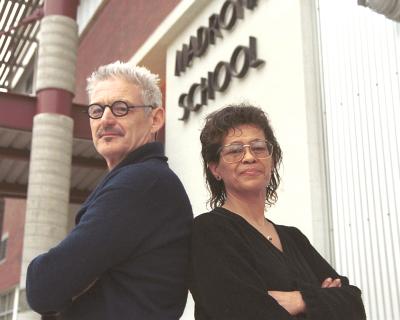February 20, 2003
UW tutors help public school students prepare for the WASL
The small elementary school gymnasium is teeming with the unmistakable energy of youth.
There’s the yelling, giggling, running and jumping. Until principal Rickie Malone raises one hand and blows a whistle. Suddenly the group of Madrona School fourth- and seventh-graders becomes practically businesslike.
“It’s amazing, the energy and excitement and then the focus,” said Gene Edgar, a UW professor in the College of Education who is a key player in a partnership geared at improving the inner-city school. “It gives me goosebumps to watch.”
The school’s fourth- and seventh-graders are now ready to greet their personal tutor — a UW undergraduate — and begin working on another lesson designed to help them pass the Washington Assessment of Student Learning, or WASL. The tutoring program, which meets on Tuesdays and Thursdays for five weeks leading up to the test, is a required after-school activity.
The one-hour sessions pair one or two of the Madrona students with one of the more than 40 UW undergraduates that are participating in the partnership. Together they work through a booklet of WASL-like problems. This is the third year of the partnership and second year there has been an emphasis on the WASL.
Last year 26 percent of Madrona students met or exceeded the standard on the reading portion of the test. Just 2 percent of students passed the math portion. Still, that was an improvement over 2001.
“I wasn’t totally convinced that we would get the results that we got,” Malone said. “Our kids, when it was all said and done, they knew and we knew that they did the best they could. In every area scores went up.”
That is the goal of the five-year partnership that is funded by Seattle businessmen Roger Rieger and Ernie Burgess. Their money covers instructional assistance, a literacy coach, school supplies and more. College of Education faculty Kathy Kimball, Ed Taylor and John Morfield, along with Edgar, are involved in the partnership. A modest grant from the University Initiatives Fund pays for the tutors, but their role in the success of the partnership is anything but modest.
Edgar recruited four “team leaders” who in turn rounded up the rest of the undergraduates. Together they comprise a formidable team that is able to connect with the Madrona students in a powerful way.
“They just look up to the college kids with such admiration,” Malone said. And Edgar knows from experience what she means.
“I wasn’t nearly as effective as the college students are,” he said. “The young kids think the UW students are cool. I filled in one time and worked with them and I wasn’t nearly as effective. The kids were a real handful. But when they’re with our tutors, they’re perfect.”
The UW students are coached to pay attention to signals the Madrona students are sending. It’s the end of a long day for children that young and keeping their attention can be challenging. Edgar encourages the UW students to form a personal relationship with the Madrona kids. He wants them to know their hobbies and dreams.
And then he wants them to, literally, talk WASL. Working through the problems is important, but the vocabulary used in the problems is critical.
“The WASL is really language latent,” Edgar said. “That’s part of the theory behind it. So they ask kids to compare bar graphs. Some kids are asking, ‘What are bar graphs?’ Or, for example, they say, ‘What are the communicative aspects of this formula?’ So we have a glossary of that vocabulary that the tutors have access to. They use those words and they define those words so the kids have practice hearing them. It’s sort of like decoding the test for them.”
The tutor and the Madrona student each have a booklet with the day’s problems in it. One of the math problems, for example, asks which among a series of four diagrams shows all the lines of symmetry for a rectangle.
The correct answer is the rectangle that is divided in two with a horizontal line and divided in two with a vertical line to create four congruent rectangles. The tutor’s copy of the booklet has the correct answer with an explanation of the answer. It also defines the term line of symmetry.
The Madrona students are scheduled to take the WASL again in April. Malone isn’t necessarily expecting enormous improvement over last year’s performance, but she is hopeful.
“We might not get as much growth this year, but I’m confident it will show some improvement or stay the same.”
In addition to the tutors, the school’s WASL effort includes a variety of creative approaches. The day before last year’s test the school had a catered breakfast for the students and their parents. During that event parents were told about some of the easy things they could do — like making sure the kids had a good night of sleep prior to the test — to make sure their child was prepared to do her best on the exam.
Classes were arranged on the day of the test so that one teacher was paired with just 12 students. Leading up to the test Malone held an assembly on the virtue of brain food. In fact, the entire school did some sort of WASL related activity during the week of the test.
Finally, she told the students that if they did as well as they could on the test they would get a one-week reprieve from their school uniforms the following fall.
“When you put that kind of emphasis and that kind of time and energy into something, kids recognize it and they automatically think, ‘Wow, this is important.’ ”



